Physical Address
304 North Cardinal St.
Dorchester Center, MA 02124
Access video content for this chapter online at Elsevier eBooks+ ![]()
Management of cleft lip requires a unique understanding of the various dimensions of care. The breadth of treatment spans multiple disciplines and the length of treatment spans infancy to adulthood. Although this chapter focuses on technical aspects of repair, treatment by a multidisciplinary team that can address all aspects of care is critical to ensuring optimal outcomes and cannot be overemphasized.
The anatomic subunit approximation approach to unilateral cleft lip repair is a measured, landmark-based repair that provides opportunities to verify the design prior to each successive step. In contrast to the cut-as-you go nature of other repairs, it has a measure-twice-cut-once character. Given that it is based upon landmarks that define anatomic subunits, the repair inherently adapts to any individual and any cleft along the wide spectrum of presentation. The repair respects and retains all key landmarks and produces a cutaneous scar positioned along the seams of anatomic subunits. At first glance, the many landmarks may seem cumbersome, however, the carefully measured design allows for efficient surgical execution and reduces the need to revise incisions. In addition, the majority of points in the repair are standard anthropometric landmarks that new surgeons should learn and that experienced surgeons should already recognize. For the less experienced surgeon, the well-thought-out plan helps with confidence. For the more experienced surgeon, the overt identification of nasolabial features can help to fine tune the surgical repair.
Landmarks are named corresponding to their embryologic origins. Sides of the face are labeled as non-cleft side and cleft side. The clefted margin of the prolabium (derived from frontonasal prominence) is referred to as the medial lip element and the opposite side (derived from the maxillary prominence) is referred to as the lateral lip element. Nomenclature is summarized in Table 19.4.1 .
| Landmarks | Notation | Definition |
|---|---|---|
| Nasal base landmarks | ||
| Subnasale | sn | Center of the columella at the columellar–labial junction/crease |
|
|
Superior extent of the philtral column. Specific to the repair, this is selected along the medial edge of the philtral roll at its intersection with the columellar–labial crease |
|
|
The most inferior margin of the ala along the alar–labial crease |
|
|
The intersection of the nostril rim with the nasal sill (as defined by the alar–labial crease) |
|
|
The alar–sill and columellar–labial creases intersect on the non-cleft side at X. The equivalent landmarks on the cleft side (X′ and X′′) are identified along the corresponding creases, equidistant to the columellar and alar base landmarks so that they define the points of nasal sill closure. When X′ and X′′ are brought together, it should produce the desired correction of the nasal deformity |
| Labial landmarks | ||
|
ls | The nadir (bottom) of Cupid’s bow along the border of vermilion and white roll (a.k.a. “vermilion border”) |
|
|
The peak of Cupid’s bow. Specific to the repair, cphi is selected along the vermilion border as Cupid’s bow transitions from a straight to a gently convex contour; and corresponds with the medial edge of the philtral roll. cphi′ is identified by reflecting non-cleft landmark to the cleft side. cphi′′ on the lateral lip element is defined by the transition of normal to hypoplastic anatomy as defined by Noordhoff |
|
|
The respective corresponding landmarks along the upper margin of the white roll |
|
|
The respective corresponding landmarks along the vermilion–mucosal border |
Anatomic subunits are illustrated in Fig. 19.4.1 . In contrast to older diagrams, the mucosa, vermilion (dry red lip), and cutaneous roll (also known as “white roll”) are each considered unique and distinct subunits. In addition, the philtral ridge is a subunit with a medial and lateral border. These have always been recognized in the original repair but are now further emphasized in Fig. 19.4.2 .
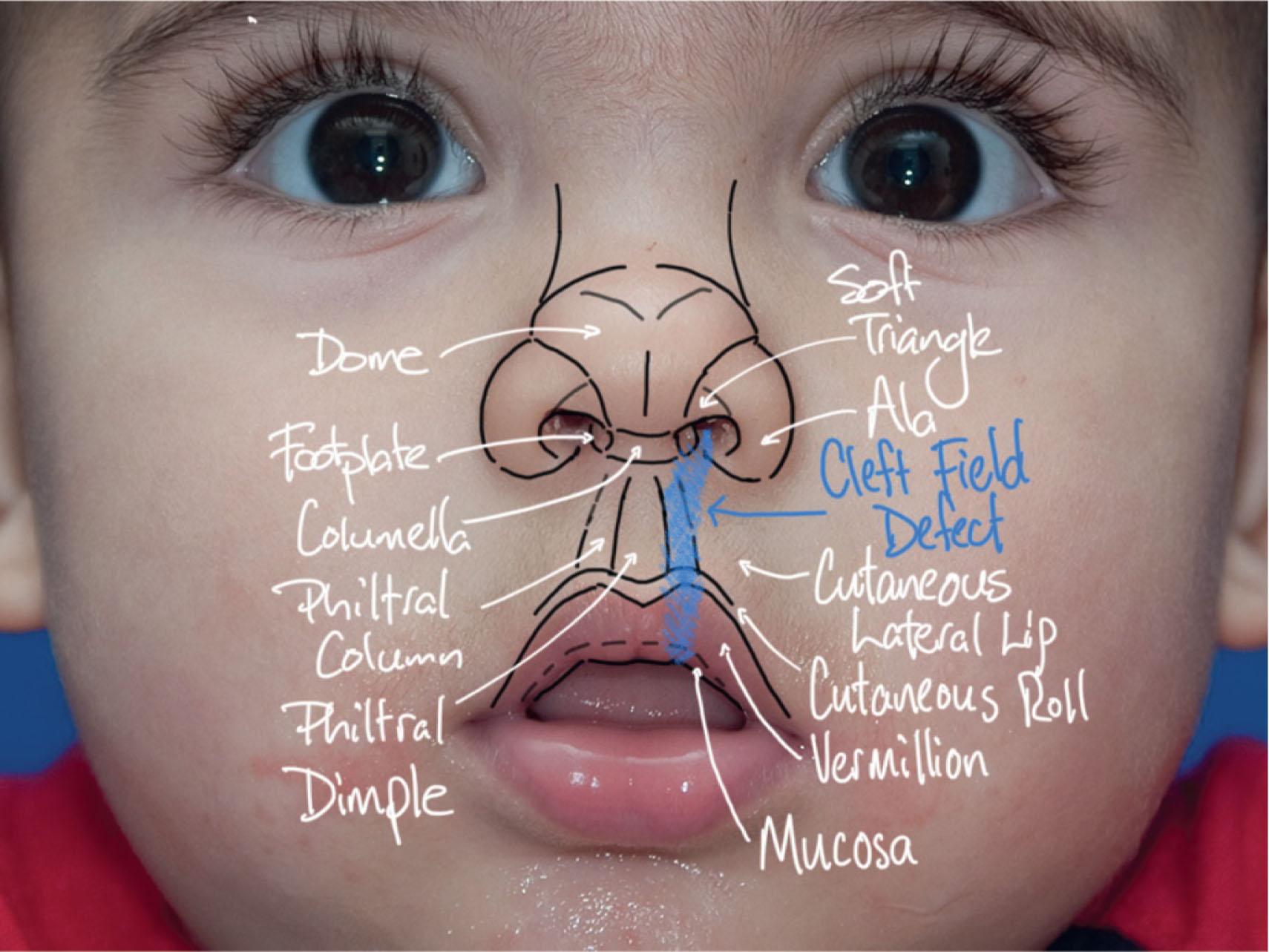
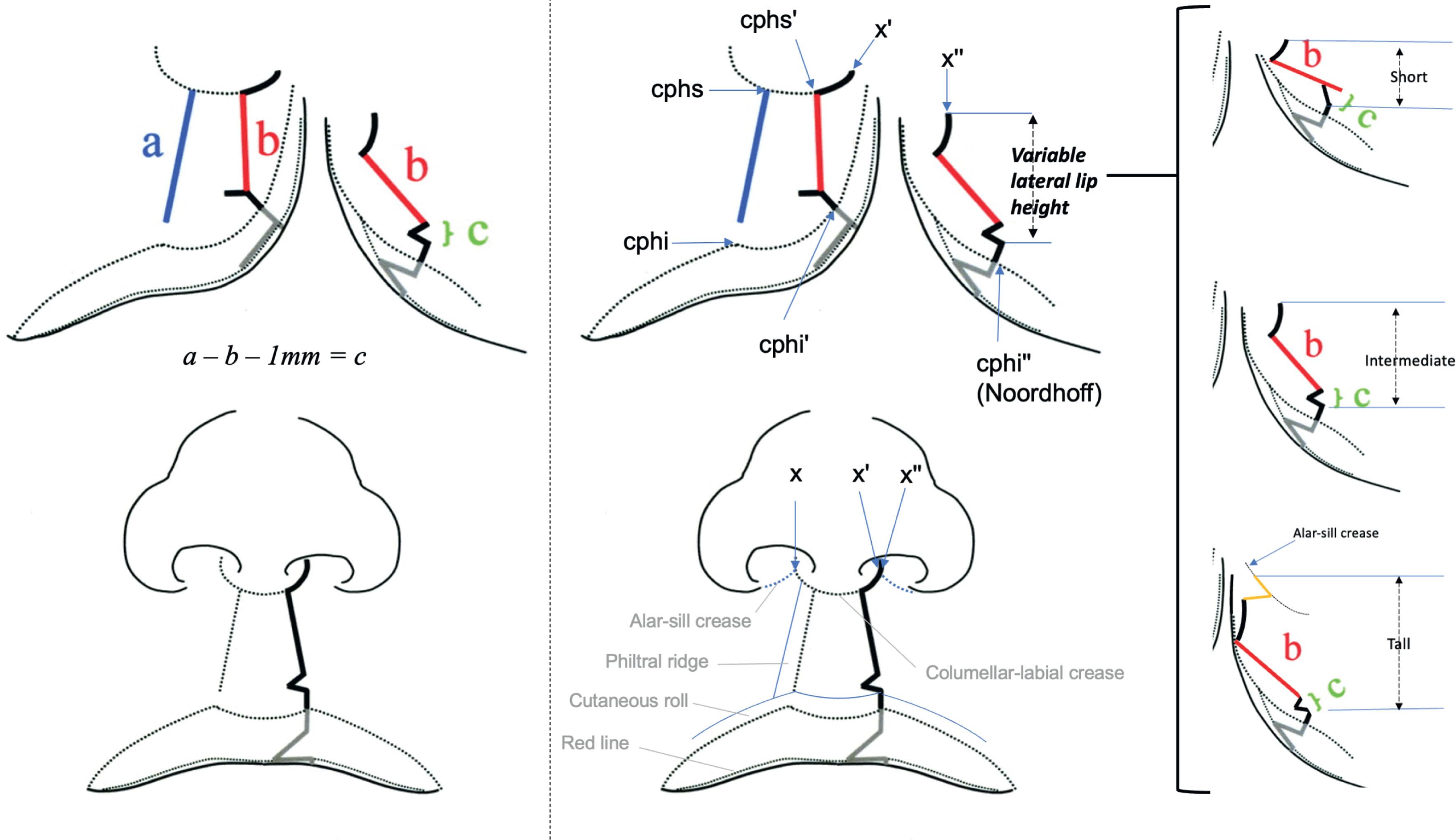
Achieving natural form, alignment, and balance are the keys to any reconstruction.
The three-dimensional (3D) twist deformity of unilateral clefts is complex and Mulliken has previously highlighted our susceptibility to optical illusion. At first glance, it appears that collapse of the nose is due to lateral displacement of the cleft alar base ( Fig. 19.4.3A ). However, when references guide our perception, it is clear that the non-cleft alar base and columella have deviated away from midline; and that the cleft alar base is retruded, but normal in medial-lateral position ( Fig. 19.4.3B ). 3D image analysis has confirmed that the degree of these displacements depends upon the deviation of anterior nasal spine away from midline. Those findings are consistent with Latham’s embryologic studies that implicate uncoupled growth of the premaxilla as the underlying cause of the nasal deformity.
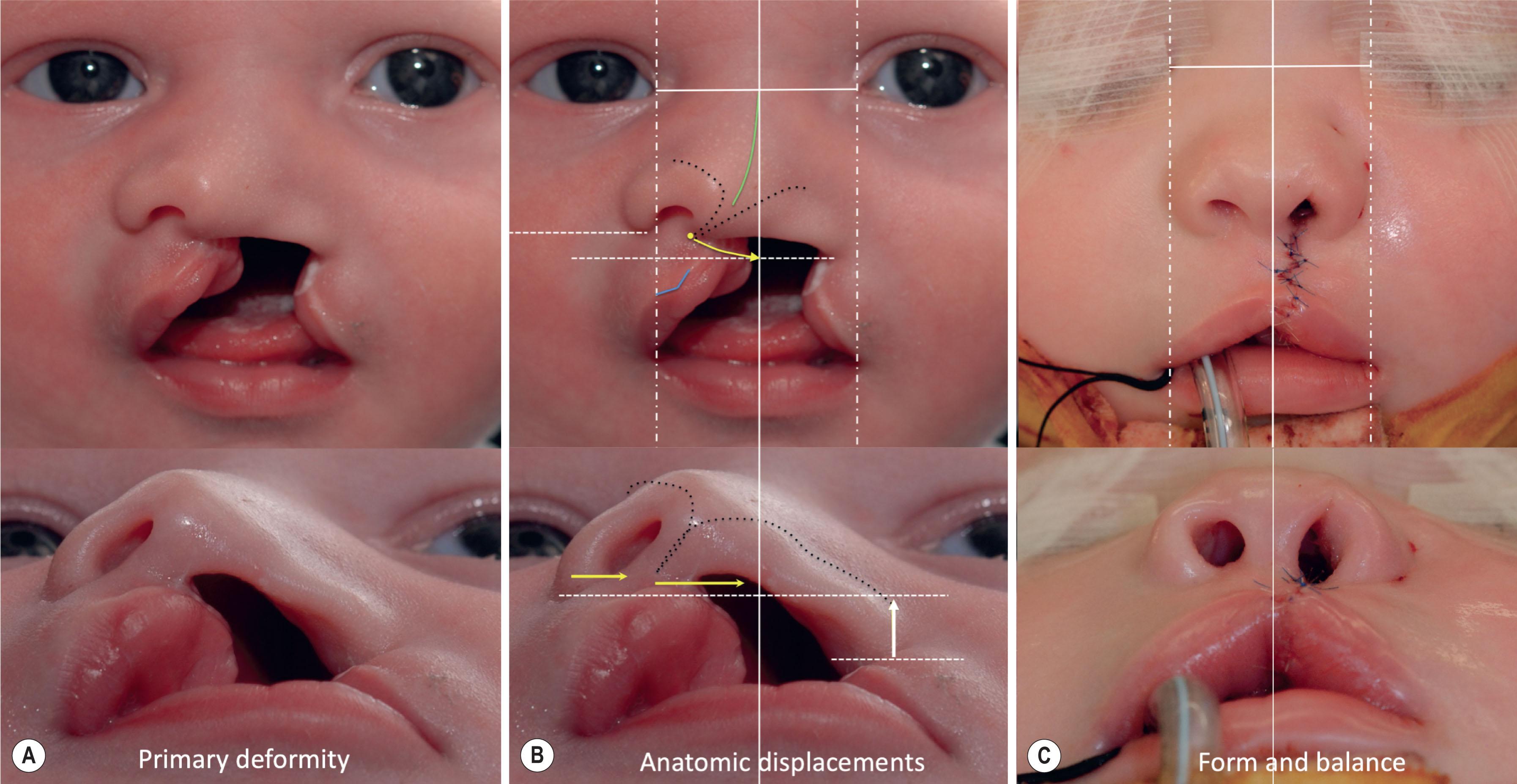
Millard and Gillies have previously espoused the reconstructive principle of “replace what is normal in normal position and retain it there”. What can be confusing is the notion that correction of the deformity involves “downward rotation of the medial lip and advancement of the lateral lip and nose”. While those movements characterize local tissue alterations of the lip with rotation-advancement repair, they do not describe the more global nasolabial movements as they relate to the entire face. The unrepaired philtrum, columella, and non-cleft alar base are displaced from midline and need to be centralized ( Figs. 19.4.3B,C ). Meanwhile, the cleft alar base needs to be advanced anteriorly , without significant alteration of medial-lateral position ( Fig. 19.4.3B,C ). Recognition of the appropriate vectors of correction are critical when identifying landmarks for anatomic subunit repair given that the design must consider the movements that achieve overall balance and facial harmony. The combination of incision design, adequate release, muscle repair, and component reconstruction can produce the appropriate tissue tensions to balance form, placing key structures in symmetric position and rotation.
On a more local scale, goals within the nasolabial region include elongating the deficient cleft side medial lip height, producing nostrils of similar size and shape, aligning the borders of distinct tissues (cutaneous roll, vermilion, and mucosa), and producing a line of closure that approximates the borders of the anatomic subunits as closely as possible ( Table 19.4.2 ).
| Form | Alignment | Balance | |
|---|---|---|---|
| Local |
|
Continuity of white roll, vermilion, and mucosal borders |
|
| Global | Correct the collapse of nasal dome | Centralize philtrum and columella | Equalize alar base positions along 3 dimensions in relation to the overall face |
When seeking to produce mirror-image symmetry, it is important to recognize that the cleft deformity is the result of opposing changes that involve imbalance on both sides of the nasolabial region ( Fig. 19.4.4 ). Assessment of 3D morphology across the spectrum of presentation has revealed that: as the cleft nasal sill widens, the non-cleft nasal sill narrows; as the cleft alar dome collapses, the non-cleft dome elevates; and as the cleft alar–cheek junction flattens, the non-cleft alar–cheek junction becomes more acute. These non-cleft-side changes occur due to constriction of the lateral crura alar ring from uncoupled premaxillary growth. While we tend to focus on the cleft-side deformity, opposing distortions occur on the non-cleft side and we cannot assume that the non-cleft side is the ideal normal . Furthermore, the non-cleft side changes with surgery . In Fig. 19.4.4 , prior to repair, the non-cleft medial footplate appears prominent and the columellar base abuts the nasal ala. Following repair, on the non-cleft side, the medial footplate flattens, the nasal sill widens, the “boxiness” of the hemi-tip softens, and the upper lip assumes a curvilinear shape with a distinctive central valley in the sill along the mid nostril (see Fig. 19.4.4 ). While the “ideal normal” does not exist before surgery, it may be revealed with appropriate corrections. Much like the dualism of ancient Chinese philosophy, “yin and yang” interconnections exist across sides and through treatment. The surgical design must therefore consider the non-cleft side if symmetry is to be achieved. The anatomic subunit aproximation is unique in leveraging opposing non-cleft-side and cleft-side landmarks as guides and reference when designing a repair.
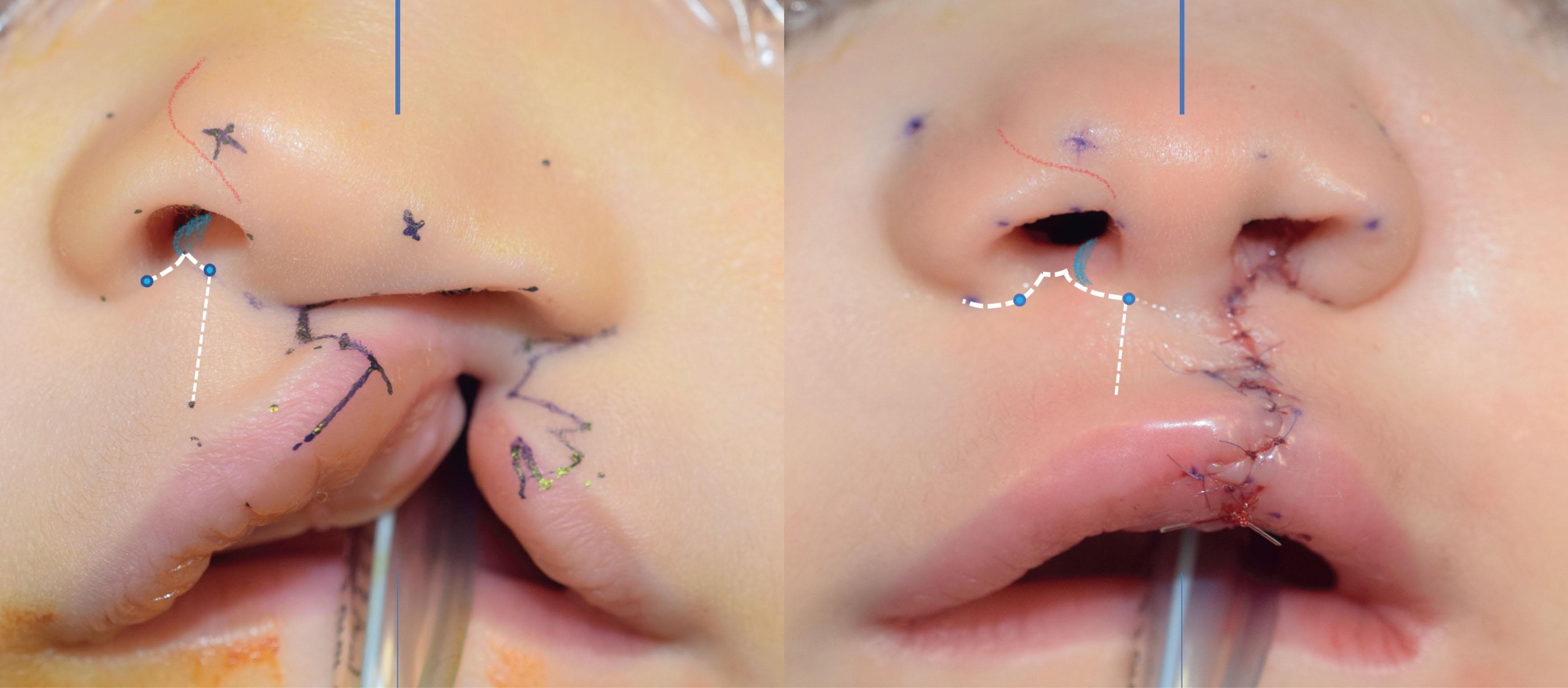
The anatomic subunit approximation approach to unilateral cleft lip repair is relatively new. It was described by David Fisher in 2005 and is a hybrid that incorporates key aspects of other repairs. It includes aspects of Samuel Noordhoff’s repair, , which is a modification of Millard’s rotation-advancement and Hugh Thomson’s repair, which is a modification of Tennison–Randall’s inferior-triangle repair. It was inspired by Burget and Menick’s concepts of anatomic subunits that they applied to nose reconstruction. The repair and its description have evolved and so has its adoption. Reconstruction of the underlying nasal foundation that occurs with repair has been described and recent study of three-dimensional morphology has further clarified the deformity, surgical objectives, and changes with this approach. This chapter summarizes the original description, clarifies modifications, and expands upon correction of the nose. All of this is in the context of recent insights.
Common to all clefts is a deficiency of medial lip height. Elongation is achieved by the Rose–Thompson effect, in which closure of a diamond-shaped excision, as a straight-line, recruits width to produce height. If additional height is needed, a small inferior triangle is positioned above the cutaneous roll. In contrast to the Tennison–Randall repair, the size of the inferior triangle is small because of the Rose–Thompson effect; the triangle is positioned in the shadows of the philtral concavity (immediately above the convexity of the cutaneous roll and lip pout); and the line of closure ascends the lip along a line symmetric with the non-cleft-side philtral column (rather than traversing anatomic subunits). The tension of the repair is positioned above the cutaneous roll, thereby accentuating the pout of the lip. The cutaneous roll is approximated end-to-end to preserve the subunit and to mimic the natural creases of the lip. Similar to Onizuka’s modification of rotation-advancement, the repair is designed to follow the columellar-labial crease and continue along the medial footplates, thereby respecting the natural contours of the nasal sill.
Whereas the cleft-side medial lip height is always deficient, the cleft-side lateral lip height and width are variable in their relative dimensions, with either or both being deficient. The anatomic subunit approach defines the lateral point of lip closure (cphi′′) according to Noordhoff. This point is considered a fixed anatomic landmark. Deficiency of lateral lip height is accommodated by closing the angles between components of the lateral lip markings (see Fig. 19.4.2 ). In contrast, other repairs, such as rotation-advancement, consider the lateral point of lip closure variable and will migrate it further lateral to Noordhoff point, thereby attaining lateral lip height at the expense of transverse lip width. The consequence of this compromise is a reduction of lip fullness when further stretching a deficient lateral lip across the cleft. Similar to an accordion, the red lip thins out and sometimes seems to “roll” into the mouth.
The anatomic subunit approximation may appear to involve the excision of excessive cleft marginal tissue. However, the repair produces a scar in the upper half of the lip that lies intermediate in position to those produced by the rotation-advancement repair and the inferior triangle repair ( Fig. 19.4.5 ). The scar of the inferior triangle repair is more lateral in the upper part of the lip, indicating that more lateral lip skin is discarded with this repair. The rotation-advancement repair, on the other hand, discards more medial lip in the form of the C-flap, which is truly discarded in many incomplete cleft repairs and is displaced from the lip into the sill in complete cleft repairs. Further discard of valuable red lip occurs when lateral lip transverse width is sacrificed to achieve vertical height when the lateral lip element is vertically short. With the anatomic subunit approximation technique ( ) medial and lateral lip elements share more equally in the discard of cleft marginal tissues. Furthermore, Noordhoff’s point, and therefore transverse lateral lip width, is never compromised to achieve vertical height.
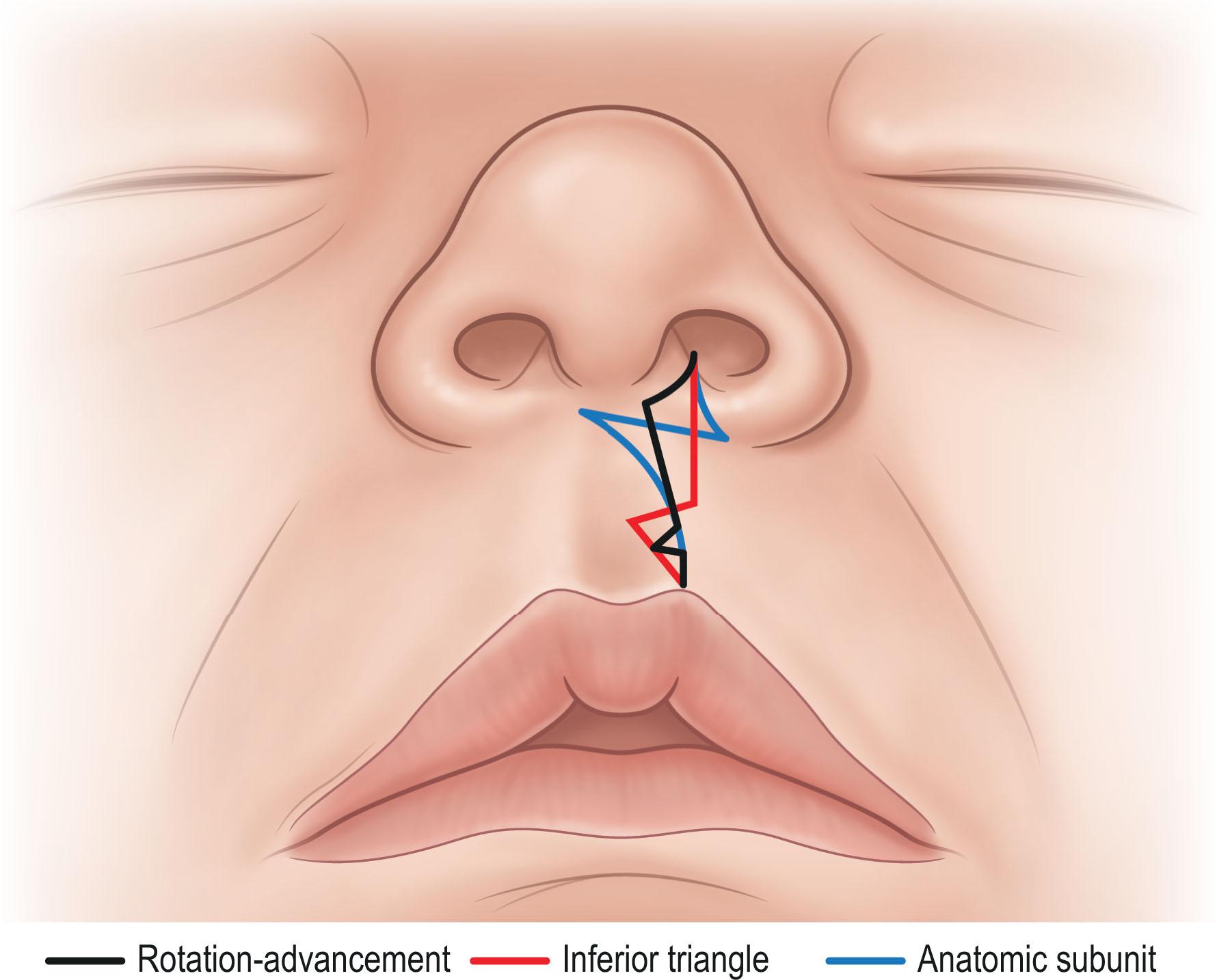
The anatomic subunit approximation inherently accommodates the spectrum of presentation because the design is based upon anatomic landmarks that are common to all patients with clefts. Measurements are used to assess the need for excisions or augmentations; the use of non-cleft-side landmarks helps to adjust the design to achieve balance; and because the landmarks are selected on the borders of subunits, the line of closure naturally follows those borders.
Landmarks are described using terminology from the original description and a modification that utilizes standard anthropometric names. In order to ensure clarity of design, they are presented in both illustration and photographs ( Figs. 19.4.2 & 19.4.6 ). Case examples also follow.
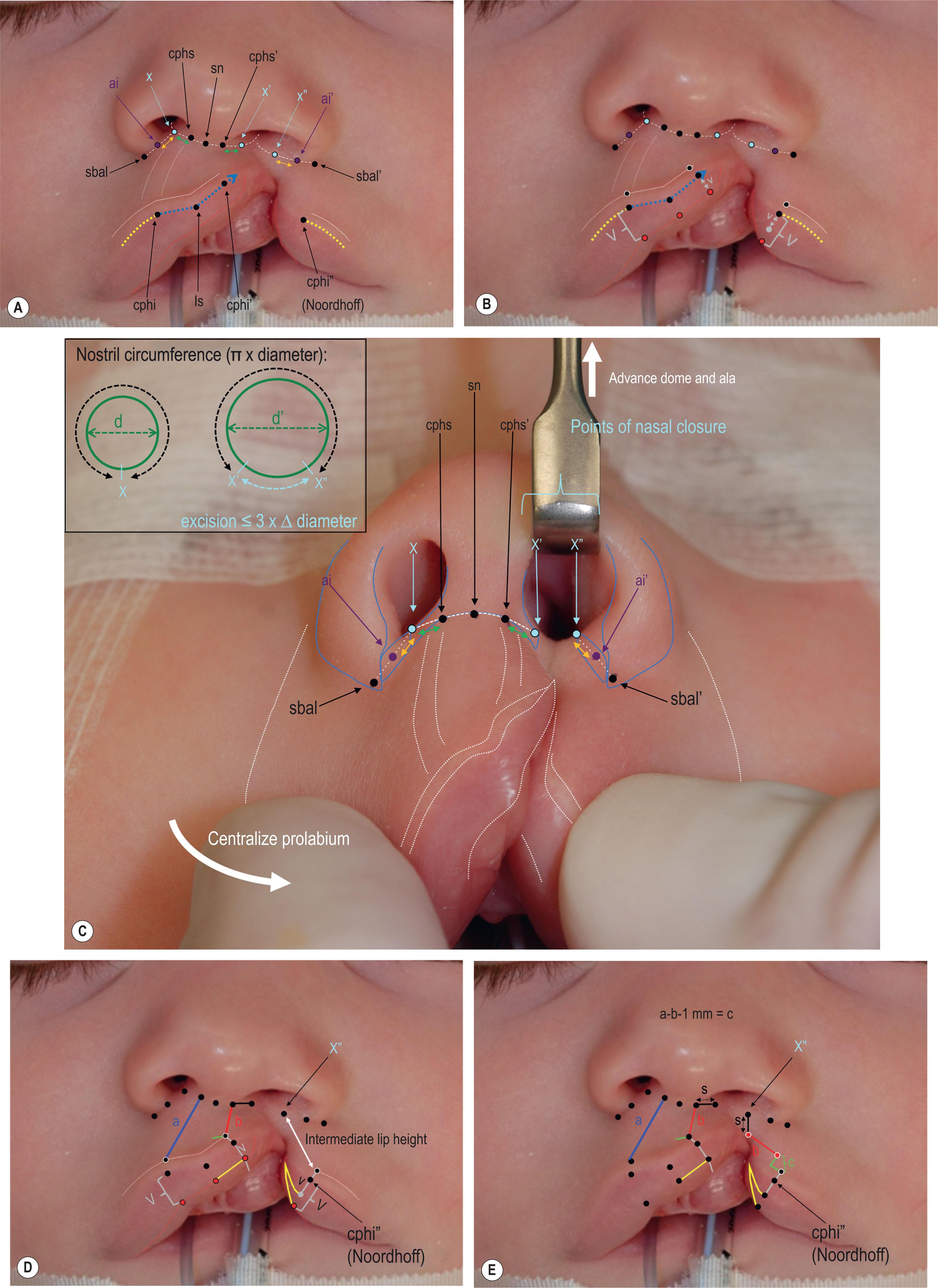
Note that while the names of anthropometric landmarks in this chapter may be used in other chapters, the specific details of their identification may differ. Given the importance of these landmarks to the anatomic subunit repair, they will each be described.
Marks are placed starting on midline structures, identifying the non-cleft side, and then, reflecting the known landmarks, to define the less distinct cleft-side landmarks.
The center of the columella ( subnasale , sn), and the height of the non-cleft philtral column ( crista philtri superioris , cphs) are identified along the nasolabial crease. Notably, cphs is identified along the medial edge of the philtral column as the convexity transitions to the shadows of the concave philtrum. The proposed height of the philtral column incision (cphs′) is identified using the corresponding non-cleft side landmark such that it is equidistant to subnasale ( Fig. 19.4.6A ).
Cupid’s bow is identified along the vermilion border and is defined by the two peaks ( crista philtri inferioris , cphi and cphi′) and its low or mid-point ( labiale superioris , ls).
Note that the non-cleft point, cphi, is not the highest point of the curve of the lip but is rather where the straight portion of the bow meets the curve/convexity of the lateral lip element ( Fig. 19.4.6A ). This location also marks the medial border of the philtral ridge, where the convexity of the column transitions to the concavity of the philtral dimple. On the other side of the bow, adjacent to the cleft, there is no such convexity and thus cphi′, the medial point of lip closure, is marked equidistant to the center of the bow (ls).
On the lateral lip element, the lateral point of lip closure, cphi′′, is identified along the vermilion border where the vermilion border and vermilion–mucosal junction (red line) begin to converge medially ( Fig. 19.4.6A ). This point was defined by Noordhoff and is considered a fixed landmark that marks the transition of normal lip to progressive hypoplasia. Medial to this landmark, the cutaneous roll diminishes in quality whereas lateral, the cutaneous roll is normal. Planning the repair medial to this point will incorporate compromised tissue in the repair. Planning the repair lateral to this point sacrifices lateral lip width and results in loss of lip fullness. It also involves discard of the natural upward convexity of the lateral lip that is necessary for recreation of a symmetric undulation of the lip.
Once all of the landmarks along the vermilion border have been identified, corresponding points ( Fig. 19.4.6B ) above the cutaneous roll (black dots with white outline) and along the mucosa–vermilion border (red dots with black outline) are identified (perpendicular to the lip). “V” and “v” are vermilion height discrepancies that will need to be addressed (as described further).
Points of nasal sill closure on either side of the cleft are defined ( Fig. 19.4.6C ) so that when they are approximated, two goals are accomplished: (1) the nostrils are equal in circumference and (2) the nasal base configuration is symmetric. Several landmarks help define these points. Subalare (sbal) is found along the ala–sill crease and is the lowest point on the ala. The alar insertion point (ai) was not included in the original description and is the insertion of the alar rim into the nasal sill. It can be found by tracing the light reflection along the alar rim until it meets the ala–sill crease.
As opposed to the lower lip landmarks, that are identified with the lip in repose, the nose landmarks are identified with the nasal deformity manually corrected. The nasal base elements are brought together (philtrum centralized and cleft side alar base advanced) and the dome is gently supported with a retractor ( Fig. 19.4.6C ). Non-cleft-side landmarks are identified first as the cleft-side landmarks are more difficult to recognize. The surgeon must look back and forth between the two sides in order to ensure that points are selected that will produce overall symmetry following repair. The orientation of sbal–ai on both sides should be similar when the nose has been corrected ( Fig. 19.4.6C ). That orientation will become asymmetric as the surgeon allows the nose and lip to slump back down to the uncorrected position ( Fig. 19.4.6A ).
Cutaneous creases can help to define points of nasal closure. In the original description, selection of those points was based upon a non-cleft-side “arbitrary point” (point #15). In the current description, points of nasal closure (X′ and X′′) are defined by the intersection of creases (X) within the non-cleft nasal sill.
On the non-cleft side, the columella–sill and ala–sill creases are followed to their intersection to define point X ( Figs. 19.4.6A,C ). Corresponding landmarks on the cleft side are defined along the respective columella–sill and ala–sill creases so that they mirror the non-cleft side relationships: the distance between sn–cphs′ and X′ is the same as the distance between sn–cphs and X; and the distance between sbal′–ai′ and X′′ matches the distance between sbal–ai and X ( Fig. 19.4.6A,C ). Appropriate points of nasal closure (X′ and X′′) should then be verified by manually bringing the selected landmarks together and ensuring that the desired nasal correction is produced, with appropriate medial-lateral and superior-inferior correction of nasal base relationships ( Fig. 19.4.6C ). Given the outward and upwards swing of the premaxilla (see Fig. 19.4.2 ), the surgeon should pay attention to the vertical relationship of the points of nasal closure as they will influence the vertical position and balance of the alar bases following repair.
If the nasal floor is intact (i.e., incomplete cleft or cleft with Simonart band) the points of nasal floor closure can be further verified by measuring nostril circumferences. Prior to placing landmarks, urethral sounds can be introduced into each side to measure nostril diameter (circumference = diameter × π). The nasal floor excision (X′ to X′′) should not exceed the difference in nostril circumferences (the difference in diameters multiplied by 3) as over-resection will produce a micronostril.
Become a Clinical Tree membership for Full access and enjoy Unlimited articles
If you are a member. Log in here